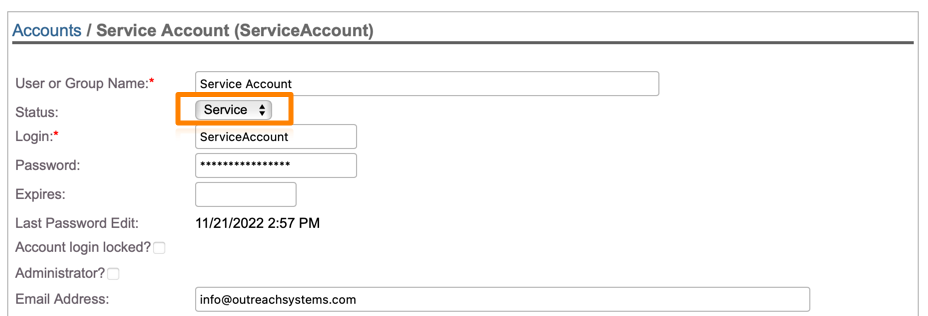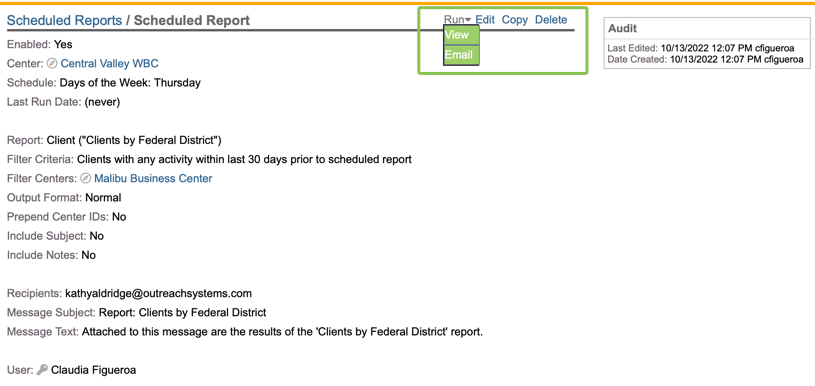How do I schedule reports and scorecards?
Any report or scorecard can be scheduled to run on a recurring basis. The results of a scheduled report are emailed to one or more recipients.
Follow these steps to schedule a report or scorecard in Neoserra:
- Select Manage|Scheduled Reports from Neoserra's menu.
- Click the New button to create a scheduled report record:
- The Center field identifies the center under which this report is being scheduled. It has no bearing on the data included in the report but it will determine the sender's email address that is used when the report is sent to the recipients of the scheduled report.
- If you are ready to enable your scheduled report upon setup then leave the Enabled? checkbox turned on. If you don't want to enable this report yet, then uncheck the box.
- Using the Schedule , Schedule Details and Months fields in combination to schedule the report to recur on a daily, weekly, monthly or quarterly basis.
To run a report twice a week on Monday and Friday, your schedule might look like this:

To run a report on a quarterly basis, your schedule might look like this, where the day of the month indicates the day within a quarter when the report should be generated:

Note: Scheduled reports and scorecards run in the early morning hours on the days you specify.
- From the Report Type field's drop-down menu, select the type of report/scorecard you would like to schedule:
- Report. If you're scheduling a built-in or custom report, select the type of report you would like to schedule (e.g. client, contact, counseling session, etc.).
- Scorecard Run Definition. If you're scheduling a scorecard, select this option.
- Goal Set. If you're scheduling a scorecard with goals attached to it and would like those goals to be part of the output, select this option. When you schedule a goal set, you can choose to have either the columnar version of the scorecard output emailed to you, or the graphical version of the scorecard. For more information on scorecard goal sets.
- From the Report field's drop-down menu, select the actual report, definition, or goal set that you would like to schedule.
- From the Filter Criteria field's drop-down menu, select from a list of built-in or saved filters to narrow down the records that will be evaluated during report generation.
- Expand the Filter Centers heading to select and include records from centers other than your current active center.
- To the right of the Output Format field, select the format in which you want your report output to display. There are up to three formatting options available:
- Normal generates your report output in a viewer-friendly and printer-friendly HTML format.
- Export Format generates your report output in a comma-delimited format.
- Dashboard (Graph), only available for scheduled goal sets, generates your report output as a bar chart focused solely on goal progress.
- From the Sort By field's drop-down list, select a sort order to apply to your report output, if applicable. The sort order options available differ depending on the type of report you selected.
- To prefix each record ID in your report output with its associated center ID, select the Prepend Center IDs? check box.
- If you are running a client activity (session, award, capital funding, milestone, etc.) report or inquiry report, indicate whether to include the subject and/or notes in your report output by selecting or deselecting the Include Subject? and/or Include Notes? check boxes. These options do not apply to some types of activity reports, such as the "Summary of..." reports.
- Enter the email addresses (separated by semi-colons or commas) of the recipients who should receive the recurring report or scorecard output into the Recipients field.
- In the Message Subject and Message Text fields, be as descriptive as possible so that recipient(s) will know exactly what they're looking at.
- Next, you will need to choose a User under whose account this process will run. If this is a personal scheduled report, then you can select your own user account. However, if you are configuring this scheduled report on behalf of a group of users, then you may want to select a special "Service" account under which to run the report. Service accounts are special accounts that don't inactivate after 180 days of no activity, but Service accounts also cannot be used to log in to Neoserra.
You can give the Service user account a distinctive name such as "Service Account" so that you can easily recognize it as a non-human account. Bottom line: employees may come and go from your program, and setting up a process under one person's account means that that account has to remain active, even after the employee is no longer associated with your program, thus creating a security risk to your data. Setting up a Service account will allow you to keep common processes running even after the person who set up the process has left the organization:

Once the Service user account has been created, we recommend you select this user for your scheduled report.
If you don't see the "Service" option on the list then you can go to Administration|Configuration|Pick Lists and edit the Account Status pick list. Here you should be able to activate the "Service" option.
- Click Save to save your new scheduled report record.

Important: If you're scheduling a scorecard definition or goal set, it's likely that you'll want to leave the default subset data in place here. This default data represents the run parameters associated with the definition or goal record that you're scheduling.
Note: If you're scheduling a scorecard definition or goal set, this filter selection is unavailable; instead, Neoserra will use the center restrictions associated with the definition or goal record that you're scheduling.
Run, Edit, Copy, Delete
Once you have configured your new scheduled report and saved your settings, you will see three command options at the top of the screen: Run, Edit, Copy and Delete:

The "Run" command offers two options:
- View: This option allows you to see the report that the recipient were to receive if the report was sent right now. The report is not actually emailed to the recipient but rather is shown on the screen for review purposes.
- Email: This option allows you to manually send the report to the designated recipient(s). Again, this is probably only done for testing purposes, because going forward the report will run automatically, but this step will help ensure that you have entered a correct email address.
The "Edit" command allows you to make changes to the scheduled report settings as required; the "Copy" option allows you to make a carbon copy of the scheduled report; and the "Delete" option allows you to delete the report, assuming you have the necessary permissions.
How do I know if the report was sent?
Each time a scheduled report is mailed to the specified recipients the success or failure is logged in the Neoserra Audit Logs. You can see whether a scheduled report was sent by clicking on Administration|Audit Data Changes. You can filter by the "Scheduled Reports" form:

Want more? Browse our extensive list of Neoserra FAQs.
